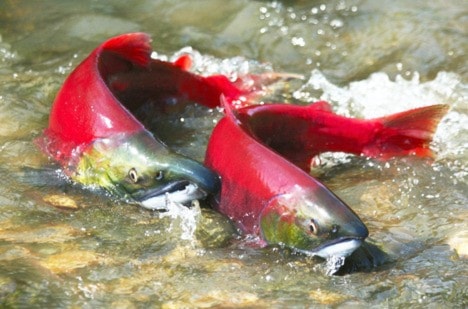If the Department of Fisheries and Oceans were using a Magic 8 Ball to determine the future of sockeye salmon fishery in the Skeena the answer would be — Outlook Not So Good.
Early forecasts for sockeye salmon are poor and there is a possibility there won’t be a commercial fishery for the year.
“We’re facing a really challenging year,” said Colin Masson, DFO’s area director for the North Coast.
The forecasts are based on the sockeye that went to sea in 2014 and 2015, as well as the number of sockeye jacks, the premature fish who return a year early. Both indicators suggest the outlook is not good.
For DFO to plan commercial fisheries, the total return of sockeye has to be greater than 1.05 million.
“If it’s less than that then we don’t plan commercial fisheries,” Masson said after he laid out the numbers.
Pre-season total return to Canada was estimated at 590,000, and that is a mid-point estimate, it could be much lower. To put those numbers into perspective, the sockeye total escapement target for the Skeena River is 900,000.
Where it gets complicated is the wide range of DFO’s estimates, where the low-point estimate goes as low as 250,000 and the high-point is 1.25 million. For planning purposes, they use a 50 per cent probability rate, which is where they get the estimated return at 590,000.
Since the levels are low, DFO has been collaborating with First Nations in the Fraser and the approach areas to develop options on sharing arrangements amongst the indigenous communities.
“We’re looking at other things. Maybe alternate species to focus on other than sockeye. Those discussions are ongoing. There are no conclusions reached at this point,” Masson said.
As for the canneries, Canfisco vice-president of production and corporate development, Rob Morely, said they haven’t had much sockeye in the last few years.
“It clearly has an impact on all our gill-net fishermen being able to make a living and it reduces the amount of product in the plants. Not a question, it’ll impact the volume of product going through plant,” Morely said.
Forecasts can be off though, maybe even enough to have a window for a fishery. In 2016, the sockeye return was 1.48 million and the forecast was for 1.28 million.
But when DFO held its North Coast salmon post-season review in November, experts presented an ongoing patter of low sockeye productivity and that 2017 may be as bad as 2013.
In 2013, sockeye returns were estimated at 453,000 — a historic low in the Skeena River — and DFO closed both commercial and non-indigenous recreational fisheries.
The integrated salmon management plan for this year is still being drafted. If sockeye numbers are as low as they’re predicting, Masson said that DFO is looking to have some contingency plans in place.
There will also be more consultation with recreational and commercial fishermen to develop a plan and possibly make adjustments to the fishery.
